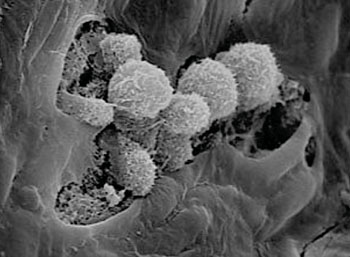Many Healthy Adults Infected with Human Papilloma Viruses
By LabMedica International staff writers
Posted on 05 Jun 2014
The largest and most detailed genetic analysis has revealed that 69% of healthy American adults are infected with one or more of 109 strains of human papillomavirus (HPV).Posted on 05 Jun 2014
While most of the viral strains so far appear to be harmless and can remain dormant for years, their overwhelming presence suggests a delicate balancing act for HPV infection in the body, in which many viral strains keep each other in check, preventing other strains from spreading out of control.

Image: Scanning electron micrograph of human papillomavirus (HPV) (Photo courtesy of University of Washington).
Scientists at the New York University (NYU) Langone Medical Center (NY, USA) analyzed data made publicly available from the US National Institutes of Health (NIH, Bethesda MD, USA) Human Microbiome Project, which is gathering information on microorganisms' effects on human health. The NIH data consisted of comprehensive DNA analyses assembled by a technique called shotgun sequencing. The DNA decoding technique helped sort through vast amounts of genetic material among 748 tissue swabs of study participants' major organs, including skin, vagina, mouth, and gut. Tissue samples were originally collected from healthy study volunteers, ages 18 to 80, participating in the NIH project. In shotgun sequencing, the genetic code of long strands of DNA is deciphered in a random firing pattern.
Some of the key findings were that 109 of 148 known HPV types were detected in study participants. Most study participants had HPV infections: 61% in the skin; 41% in the vagina, 30% in the mouth, and 17% in the gut. Of the 71 study participants infected with HPV, 42 (59%) had HPV in only one organ, 22 (31%) had it in two organs, and seven (10%) had it in three; none had HPV in all four organs tested. Skin samples contained the most varied HPV strains with 80 types of HPV, including 40 that were found only in the skin. Vaginal tissue had the second most numerous strains 43 types of HPV, with 20 strains exclusive to the organ.
In mouth tissue there were 33 types, of which five were exclusively oral in origin, and six types were found in gut tissue, all of which were found in other organs.
Zhiheng Pei, MD, PhD, the senior investigator, said, “The results also highlight the weaknesses in current clinical test kits for HPV, currently designed to recognize only a dozen or more viral types most closely tied to cervical cancer. Broader detection methods and comprehensive diagnostic tests are needed to more accurately assess people's "true" HPV infection status.” The study was presented at the annual meeting of the American Society for Microbiology on May 20, 2014, in Boston (MA, USA).
Related Links:
New York University Langone Medical Center
US National Institutes of Health














